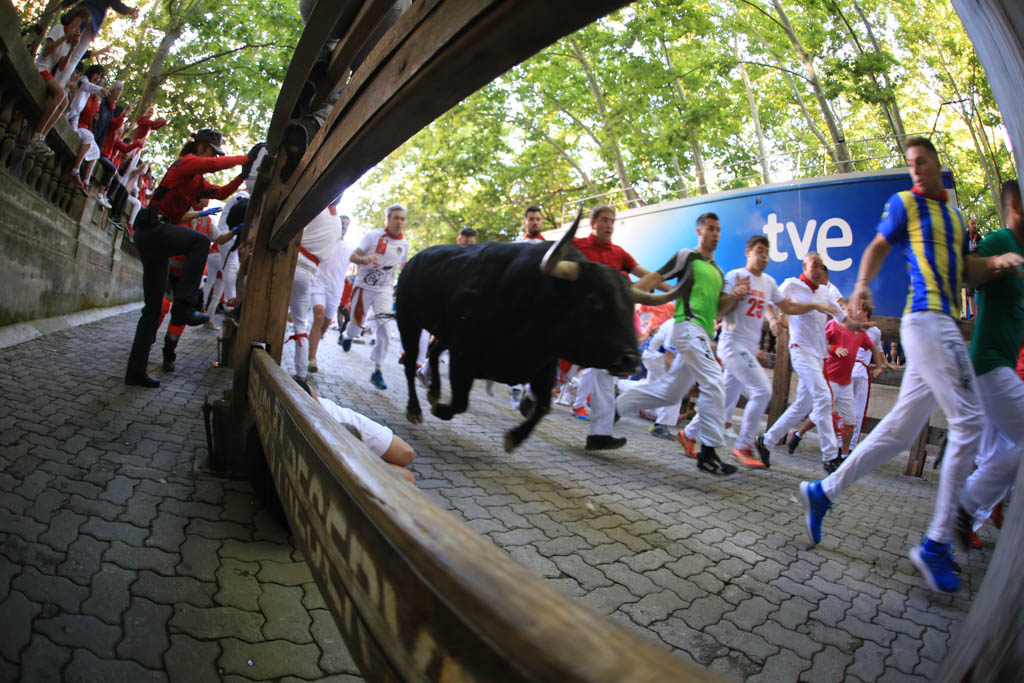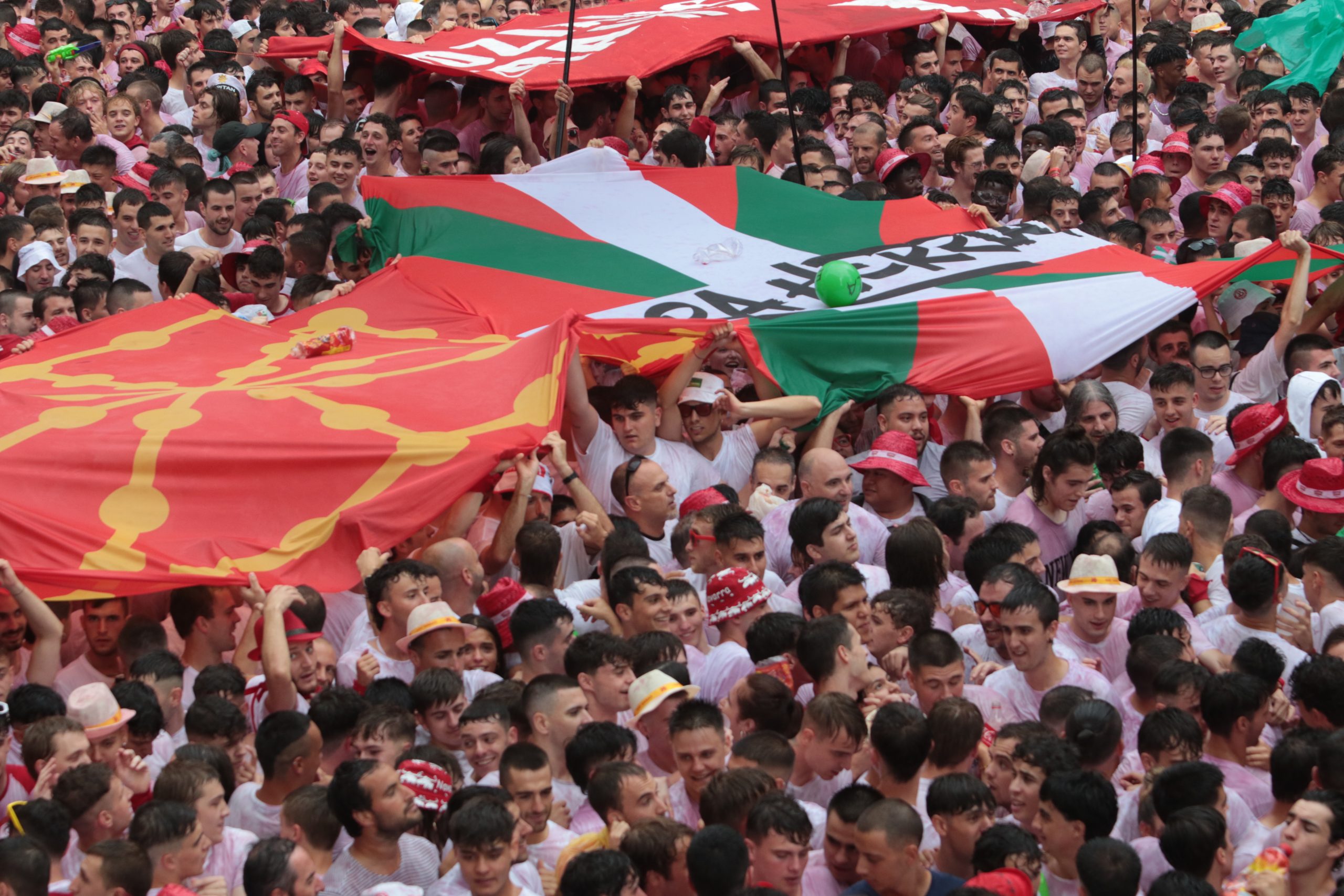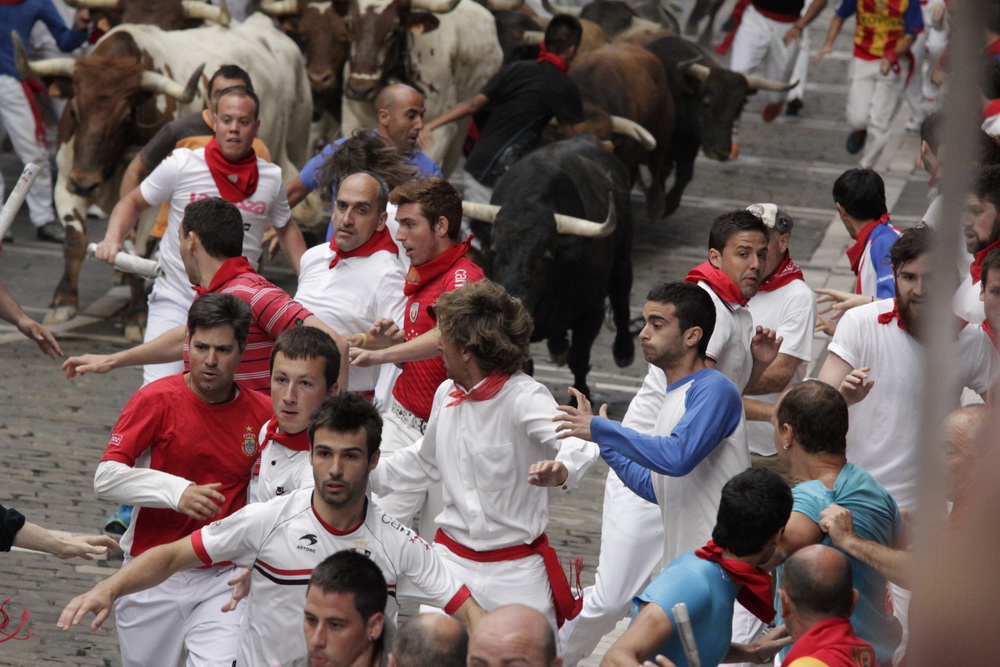The corrida or bullfight during San Fermin is very different to bullfights in any other big bullring in Spain or anywhere else. First of all, because it’s organised by the “Casa de Misericordia” or “Meca” (Old-Folks Home) and the profits go towards the upkeep of this charitable institution. This philanthropic end makes it somewhat easier to pay the expensive prices. Additionally, the bullfight is a continuation of the pandemonium which is going on in the street during these festival days. It is just another platform for getting on with the basic function of the “fiesta”, which is to have a hell of a good time and to eat and drink over the top. For many people, the start of the bullfights is the start of the day (the bullfights start at 6.30 in the afternoon!).
Feria del Toro 2022
5 de julio 20.00 Novillada. Plaza de toros. Jorge Martínez, Isaac Fonseca y Álvaro Alarcón con toros de Pincha.
6 de julio 18:30 Corrida de rejones Plaza de Toros. Leonardo Hernández, Roberto Armendáriz Y Guillermo Hermoso De Mendoza con toros de El Capea.
7 de julio 18:30 Primera corrida. Plaza de Toros. Pablo Hermoso de Mendoza, Morante de la Puebla, El Juli Y Andrés Roca Rey con toros de Núñez del Culvillo y El Capea (rejones).
8 de julio 18:30 Segunda corrida. Plaza de Toros. Daniel Luque, José Garrido Y Álvaro Lorenzo con toros de Fuente Ymbro.
9 de julio 18:30 Tercera corrida Plaza de Toros. Joselito Adame, Rubén Pinar Y Javier Cortés con toros de D. José Escolar Gil.
10 de julio 18:30 Cuarta corrida. Plaza de Toros. Rafaelillo, Manuel Escribano Y Leo Valadez con toros de La Palmosilla.
11 de julio 18:30 Quinta corrida. Plaza de Toros. Juan Leal, Román Y Jesús Enrique Colombo con toros de Hros. de D. José Cebada Gago.
12 de julio 18:30 Sexta corrida. Plaza de Toros. Diego Urdiales, Alejandro Talavante Y Ginés Marín con toros de Jandilla.
13 de julio 18:30 Séptima corrida. Plaza de Toros. Miguel Ángel Perera, Paco Ureña Y Andrés Roca Rey con toros de D. Victoriano del Río Cortés.
14 de julio 18:30 Octava corrida. Plaza de Toros. Antonio Ferrera (sobresalientes: Álvaro de la Calle Y Jeremy Banti) con toros de Miura.
Sun & Shade
In most Bullrings there are marked differences between the seating in the shade and the seating under the hot sun. A different way of viewing the spectacle and not only in the physical sense. This difference is particularly true of the Pamplona bullring during Sanfermin. In most Bullrings there are marked differences between the seating in the shade and the seating under the hot sun. A different way of viewing the spectacle and not only in the physical sense. This difference is particularly true of the Pamplona bullring during Sanfermin.
Seats in the shade are found in the sections 1, 2, and 3. Sections 4 and 7 share both sun and shade depending on the hour. Here, where the public are not roasted by the strong sun, prices for these seats are the most expensive and the public is better behaved. If your intention is to watch the bulls with genuine interest, get a seat on this side. Here, you can watch the bulls in peace without suffering any distractions. The real fans of the bullfights are found in these seats. Make sure you arrive on time- before 6.30 when the first fight starts. Once the bull is in the ring, it is not permitted to allow late-arrivals to take their seats until that bull is killed.
It is also a good idea to hire out a cushion to sit on. You can find them at some small stalls inside the stadium. Seats in the shade are found in the sections 1, 2, and 3. Sections 4 and 7 share both sun and shade depending on the hour. Here, where the public are not roasted by the strong sun, prices for these seats are the most expensive and the public is better behaved. If your intention is to watch the bulls with genuine interest, get a seat on this side. Here, you can watch the bulls in peace without suffering any distractions. The real fans of the bullfights are found in these seats. Make sure you arrive on time- before 6.30 when the first fight starts. Once the bull is in the ring, it is not permitted to allow late-arrivals to take their seats until that bull is killed. It is also a good idea to hire out a cushion to sit on. You can find them at some small stalls inside the stadium.
The seating in the sun is in sections 5 and 6 and in the upper seating at 10 and 12. Here is where the “Peñas” gather, under the fierce heat of the merciless sun. The party atmosphere is in full swing here and watching the bulls fight could be purely incidental for some of the crowd. (Some would say purely accidental!) The party atmosphere means that eating drinking and singing to your hearts’ content comes first and foremost.
The only problem is the limited number of tickets. But that is something you can read about in the later sections. So, even if you have no interest in bullfighting and even have some moral objections to it, you can safely sit among all the pandemonium on this side and scarcely be aware that there is a bullfight going on.
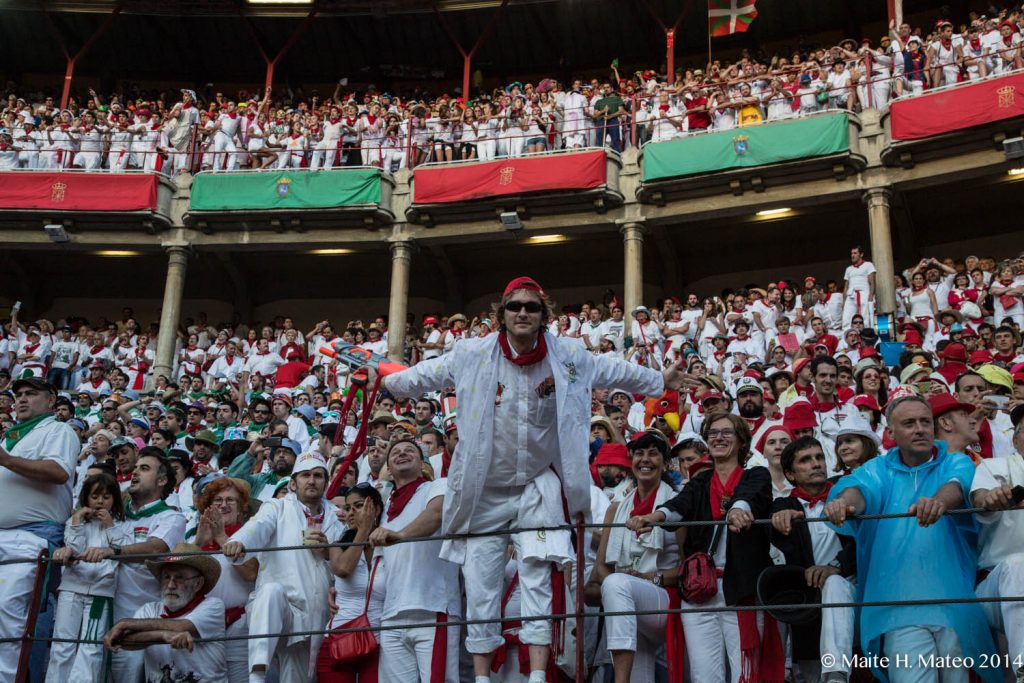
© Maite H. Mateo
How to get tickets
Trying to get tickets for the daily bullfights is a continuous headache, not only for the foreigners, but also for the local people. The following information will maybe help you. The Bullring is divided into three tiers. There is the “Tendido” which is the section closest to the arena, There is the “Grada” or Terrace, which is the middle section, and there is the “Andanada”, which is the upper section. Each of these three tiers rings round the whole stadium which is further divided into a “sun” half and a “shade” half.
The cheapest seating is found on the upper tier. This is where the “Peñas” gather on the “sunny side of the ring. The terrace is more expensive but also more peaceful, even on the “sunny” side. The “tendido” is the most expensive section of the ring. Here, the real fans tend to sit, as far away as possible from the “frivolous attitudes” of the “Peñas” which have been already described before.
Official distribution of tickets
Most of the seats in the bullring belong to members who pay an annual fee and who automatically receive their tickets each year to cover the seven consecutive days of bullfights. This membership is automatically renewed each year and most of them pass from father to son so that even for the local people there is a waiting-list that practically only opens on the death of a member.
“The Peñas” also have lifelong membership which allows them to receive tickets in bulk so that, for example, the seating that they occupy on the sunny side of the ring is totally booked out by them each year. Only 10% of the total tickets are officially on sale – and this happens only because they are legally required to do so. This 10% of tickets are sold the day before each bullfight at special box offices just in front of the bullring and which open at nine o´clock in the evening.
So, in theory, if you are prepared to queue up, you can get tickets in this way. In fact, what tends to happen is, the black marketeers tend to control the queue to a great extent. They take up position hours before the box-office opens and buy up a large portion of these entrance tickets so that they can resell them at a higher price.
Only four tickets per person are issued, but even this doesn´t usually hinder the black marketeers, as they employ friends and relations to control the queue and to buy up as many tickets as they can. The reality is that someone, after spending a lot of time queueing up, can find that the sold-out sign is put up before he even gets to the window. You can find more information about the official distribution of tickets in the Feria del Toro website or in shop.sanfermin.com.
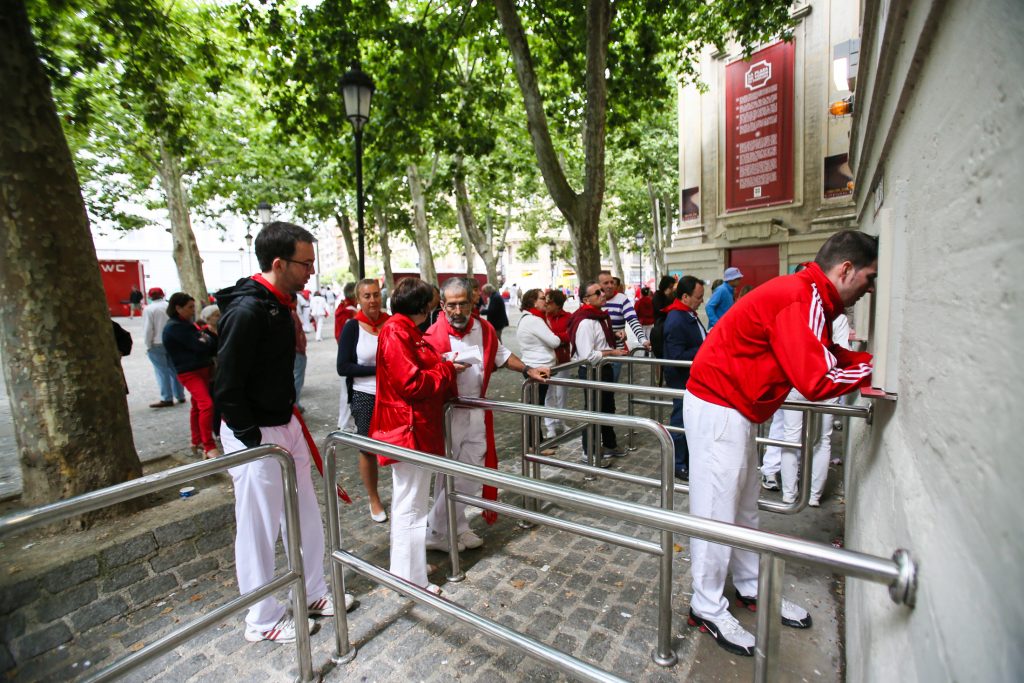
© Javier Martínez de la Puente
Black market tickets
What´s the answer ? Perhaps, the easiest thing to do is, to forget your pride and pay up, even if you have to pay nearly double. This practise is illegal of course, but not very strictly enforced. And, if it were, would only affect the seller, not the buyer. So there is nothing to worry about in that sense.
These ticket touts can be found all round the perifery of the bullring from the morning of the bullfight and right up to the last moment in the afternoon just before the bullfights begin. They are usually collected round the end of Estafeta Street and the corral which leads into the ring.
If you decide to buy one of these tickets, first make sure you know what kind of seating you want, so that you can be clear about what you want to buy. Then look for your tout. They tend to be an unmistakable class of person, whatever part of the world you live in, and to ensure we are being politically correct people, we won´t go into details here. There isn´t much point either in hustling from one to the other. Put one of those puzzled looks on your face as if you are looking for something, and you will soon be approached by one of them. (having at least a smattering of Spanish would be a help here – this class of person doesn´t usually tend to excel in languages!).
Advises for buying black market tickets
-It´s also useful to be up on the current price of these tickets. Prices can vary highly from day to day. They are a good deal more expensive at weekends when there is a large influx of people. The popularity of the different bullfighters is also another important factor. Check out which bullfighters are on the programme for that particular day. With a bit of luck a mid-week ticket should be quite a bit cheaper than a week-end ticket. It´s difficult to say just how much you would have to pay. You can expect to have to pay at least the double without taking into consideration the extra factors such as week-end tickets, special demands, particular bull-fighters, etc.
The official price is stamped on each ticket so check it before you make an offer to the tout. You will also see the number of the entrance door on the ticket, as well as the section number and the seat number. You can enter the stadium through any of the gates, but there is a check at the entrance to your section and this is when it is necessary to have your ticket to be allowed through.
–Check the date on the ticket. (You could run the risk of being offered an unsold ticket from the previous day´s fight, which is now totally valueless.)
-You can bargain with the tout (in fact, if you are a foreigner, he will be particularily hard at bargaining with you.) and keep in mind the question of whether your seat is in the sun or in the shade – as we have pointed out earlier, a seat in the shade is considerably more valuable.
–Another important factor is the time that you buy the ticket. The closer it is to the opening of the bull-fight (6.30 in the afternoon), the cheaper the value of the ticket since the tout will be desperate to get rid of the ticket before it becomes too late to sell it. If you risk waiting till the last moment, there is a good chance to getting the ticket at it´s face value. But if you wait too long, you run the risk of missing the first bull. (late arrivals will only be admitted after each bull is killed). There is an added risk if you have a ticket among the “Peñas”- even though your seat is numbered, someone may already be sitting on it (perhaps because some friends are there) and it may be difficult to move them.
Unused tickets
There is another source for available tickets, a good deal less “professional” than the ticket touts. Not everybody wants to go every day to see each bullfight, even though they have their member´s ticket to do so. Particularily among the “Peñas” some of the people need to take a day off from the hectic pace now and again. You may see a group heading for the ring and they often have an extra ticket or two when one of their friends drop out at the last moment. If someone asks them for one of these unused tickets then they will usually sell it at face value. It´s all a matter of keeping your eyes open and watching for them as these friends often arrange to meet up somewhere close to the ring. And then you have to be lucky enough to be the first to ask them for a ticket.
This method is employed by the local people and it usually works more than you might expect. It´s a question of hustling from group to group at the last moment. A good hustling place tends to be in Amaya street just in front of the bullring.
If it´s any consolation, the bullfights are usually even more enjoyable when you have hassle for the tickets in this way.
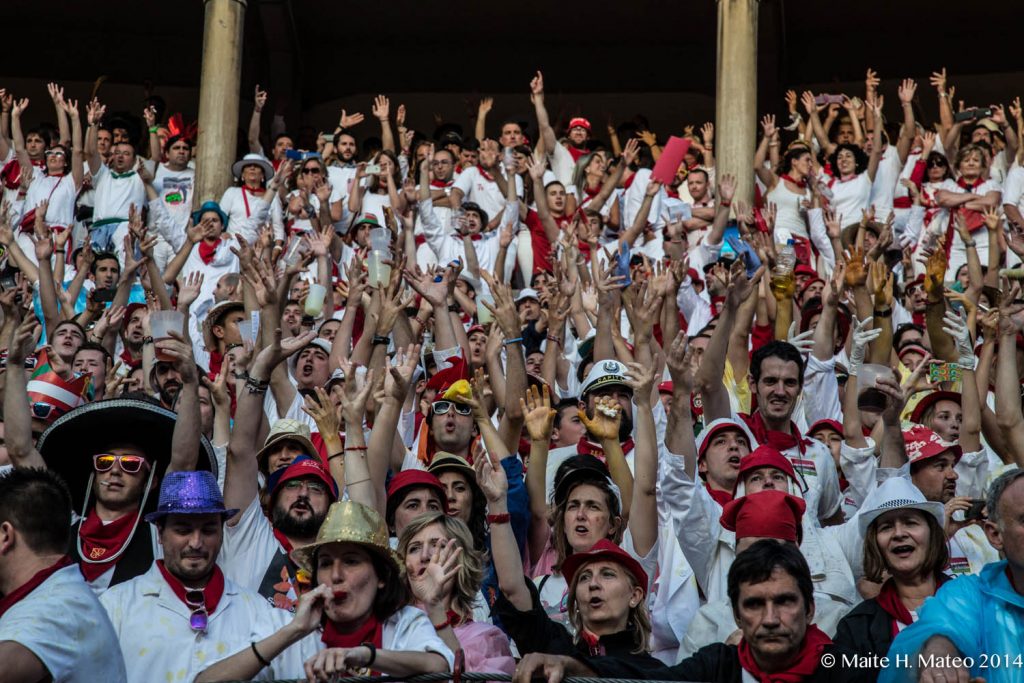
© Maite H. Mateo
Unforgettable at sun
Even if it is not necessary to be a member to sit with them, most of the sunny side of the ring is booked out and it is very difficult to get a place. This whole side of the Bullring is pure spectacle and pandemonium. Even if it is not necessary to be a member to sit with them, most of the sunny side of the ring is booked out and it is very difficult to get a place. This whole side of the Bullring is pure spectacle and pandemonium.
Once you have succeeded in getting a ticket remember to arrive in good time to take your seat. You should try to get there by six o`clock. If you are late you may find that someone has occupied your seat and it may be difficult to move them. Arriving at the last moment could mean that you are confronted with a packed crowd that makes it physically impossible for you to reach your seat. You might be left standing at the back with little or no comfort.
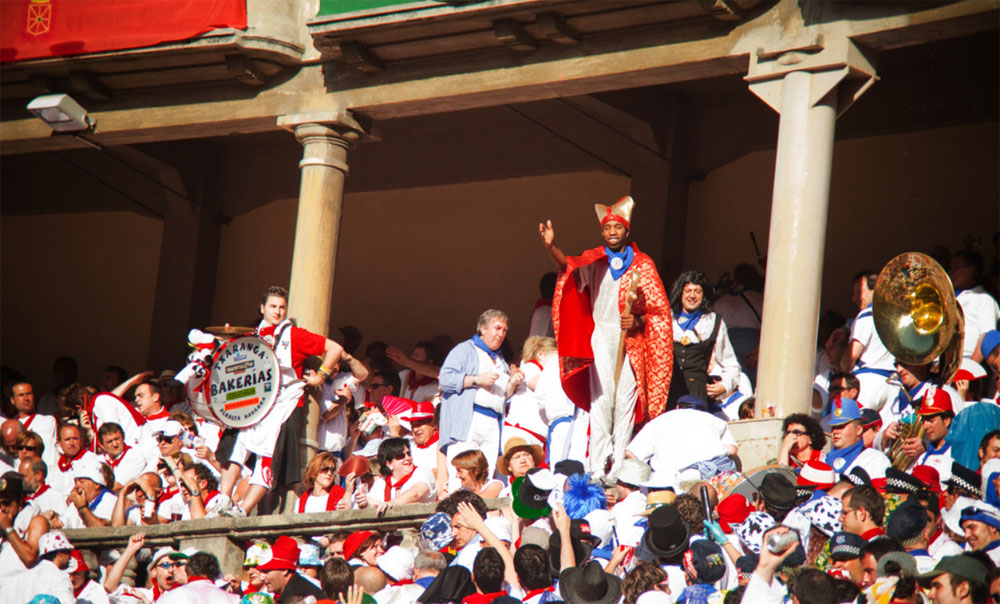
The bullfight on this side is usually hot and dirty. Come well prepared.Take a straw hat – the July sun can sometimes fry your scalp. Sunglasses might be a good idea too. The “Peñas” will be wearing their distinctive-coloured smocks so that, should any kind of “flour fights” start, they don´t worry about getting dirtied. Better to wear your oldest clothes, or, if you value your clothes,bring a towel or somesuch thing to protect you from any “flying objects” which may be thrown in good-natured fun, but which will leave a dirty stain should they find their target. You will notice that the locals on this side of the ring will wear any old thing to the fights, sometimes just to be funny, but believe me, they are also thinking of the muck and grime that tends to proliferate there.
A cushion to put under you is not a bad idea either, even if it is only useful for the first minutes. The concrete seating will have already taken a battering from the previous day´s fight and there also tends to be a lot of spilled wine floating around. These can be hired out just inside the stadium for a modicum sum. So, keep your good gear for the night scene and you won´t have to regret any “accidents” that could take place when the wine, sangría, etc, overspills both inside and outside its owners.
Neither is it a good idea to take cameras, something which visitors tend to do. They could run the risk of getting badly stained by the flowing wine or “kalimotxo” (a mixture of red wine and coke) which are being abundantly consumed to allay the fierce heat of the sun. Anything valuable is best left somewhere in a safe place.
Eating and Drinking at the bullring is one of the most attractive aspects (Some would say the most attractive) of the whole show. The drinking usually commences pretty early on. More likely than not the fierce heat of the afternoon sun will be beating mercilessly down on the sunny side of the ring. Sangria tends to be the most popular drink, which, funnily enough, is hardly ever drunk in Pamplona during the rest of the year.
It´s understandable that foreign visitors go away from the Fiesta thinking that it is our national drink, but nothing could be further from the truth. Rigid protocol dictates that, after the third bull has been killed, it is time to open the lunchboxes. Many people meet up with their friends in the passageways under the stadium to share their meal, which means that there is usually more seating space available on the terraces.
The lunchboxes can hold anything from a breadroll sandwich to a full three course meal depending on the taste of each person. Some people even bring coffee and liqueurs to finish off their meal in style. (So you can understand why some people don´t tend to return to their seats to watch the remainder of the bullfight). On the way to the stadium you will see all kinds of people proudly bearing all kinds of opulent lunchboxes. (Here is one of moments when a little ostentatiousness is acceptable). For many people this will be their main meal of the day.
A sense of wellbeing and camaradie abounds at the bullfight and there is usually an opulent amount of sharing out of food going on with the people round you, be they friends or strangers. Here, you have the chance to taste all sorts of popular food from the Navarra region. The people understand that the foreign visitor is not “up” on the protocol on this type of occassion and they are particularly generous at sharing their food with any foreigners that are sitting near them. This eating and drinking tends to build up to a climax all through the second part of the bullfight and the spirits of the spectactors rise correspondingly. There is no point in taking home leftovers so these leftovers often start getting flung round in all directions as some people seem to feel a need to “practise” their volleyball skills. So, remember to take some victuals and beverages with you to the bullfight.
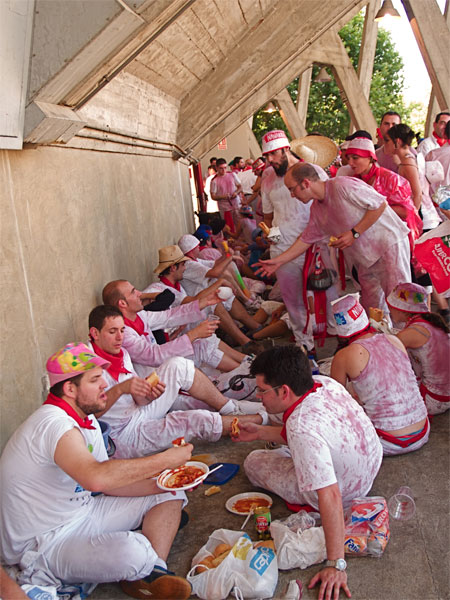
Later, as soon as the bull-fight finishes and the crowd leave, an assorted group of scavangers, made up of all kinds of “underground” types, be they “punkis” or whatever, tend to scour the terraces for the suculent leftovers. So, if you are an open, tolerant and fun-loving type, you will probably have realized by now that this could be just the kind of thing you would enjoy. If it doesn´t sound much like your kind of fun, then give it a miss. There are plenty of other things going on at the same time in Pamplona that could be more in your line.
When the last bull has been killed and dragged from the ring, the “Peñas” and a large part of the crowd pile down into the ring and gather in disordered groups under the different banners ready to flow out through the main gate behind their raoucous brass bands.
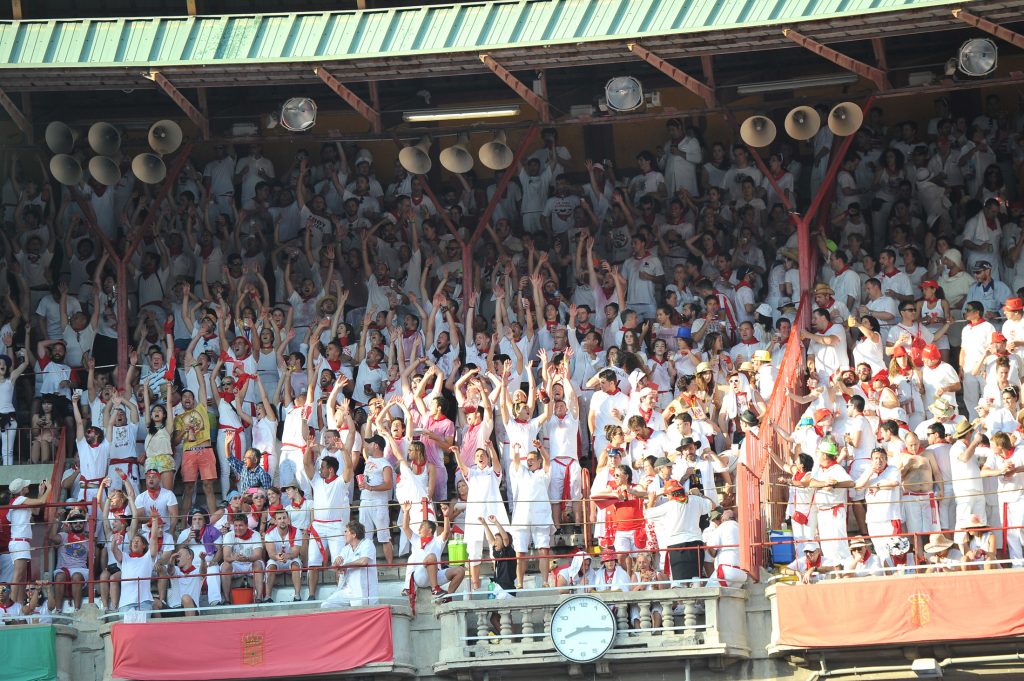
Andanada en sol en pleno gozo sanferminero. © Maite H. Mateo
The layout of the bullring
The Pamplona bullring is the third largest in the world and it is packed out for each day of the Sanfermines. Its management is run by the Casa Misericordia de Pamplona – a charitable institution and this organization regulates and controls all aspects of the bullfights and shows held there.
While there are a total of 19,721 seats in the bullring only 1,950 of these are put up for sale to the general public the day before the bullfight takes place. The ticket offices at the bullring usually open at 20.30 pm on the eve of the bullfight. These tickets are exclusively for the highest tier of the bullring known as the ANDANADA – the grandstand section of the bullring and, as such, they are the cheapest tickets available. Entries for the regoneo – the bullfights on horseback and for the novillada young bulls events are handled in a different way. (These take place on the two days before the classic bullfights open on the 7th of July).
The vast majority of the tickets for the bullfights are season-tickets which are renewed each year by the season ticket -holders during the final days of June. The season-ticket holder is then able to do as he pleases with his ticket and so these tickets can be sold in the street on those days that the owner decides that he will not go to the bullfight.
How to enter to the bullring
While there are designated entrance gates, it is not particularly important to use any special one, as inside, the whole ring has circular passageways which connect the whole ring. Gates are indicated by letters from A to G and there is no Gate F as it was eliminated with the last piece of rehabilitation work carried out on the bullring in 2005. There also exists a main gate to the bullring as well as a “patio de caballos” gate which is used by the ringside employees and the back-up team of each of the bullfighters for their different functions. In any case, if we follow the indications written on the entry ticket we will get more immediate access to our seat. Gate A is found nearest to the side where the “patio de caballos” lies and Gate G is at the opposite side facing towards the Media Luna Park and near to the side of the bullpens.
From the outside the different seating areas can be distinguished and we need to recognize these if we want to find our correct place. The tendido or front rows of seats are found at ground level and closest to the arena. Behind them there is the grada or stand area and above that, the andanada or grandstand area. This section was added when Rafael Moneo, the famous architect from Tudela, renovated the bullring some years ago.
The original design of the bullring is from the architect Francisco Urkola, who used the same outline as he had earlier used for the Monumental Bullring in Seville. Reinforced concrete was used along with an iron structure and as, at that time people still distrusted the strength of the concrete, the amount of iron used is higher than that of cement. For this reason the later amplification of the bullring was easily supported by the original structure. Safety is guaranteed for all the public who attend shows held inside the ring. From the outside the different seating areas can be distinguished and we need to recognize these if we want to find our correct place.
Seating layout
To know where you can find your seat to enjoy the bullfight, a detailed description of the seating arrangements is outlined as follows. The bullring is divided into three different layers of seating: tendido – the front row seating, grada – the stand seating and andanada, the grandstand seating. Each section of seating is respectively further away from the arena and with less comfortable seating. However, the arena can be adequately viewed from all three sections. .
Tendido – Front row seating
From the ringside fencing the front rows reach back to the tabloncillo which is the end row of the tendido section. This the best way of seeing the bullfights as you are very close to the action. It is important to bear in mind that in Pamplona there are nine rows of seating and the number of each row can be easily read from the ring as it is painted on the ringside barriers.
The best places in the Pamplona bullring are in the reserved seating area and rows, 1, 2, 3. The reserved seating area is included in these front rows but it is the area facing the bullpens and access is gained from the main gate and gates D and C. This area includes the reserved seats which are made of wicker instead of cement and these have cushions and stretch from the ringside up ten rows. This area is even more comfortable than the president’s box and it is obviously one of the most expensive locations in the bullring.
This area also include the preference barrier which is the first of the rows with seating. You can lean your arms on the barrier which divides the narrow passageway which circles round the ring behind the main barrier which separates the arena from the seated public. Thus, you get a close view of the bullfighters and their back-up personnel as they wait to enter or leave the arena. Only those directly opposite the bullpen belong to preference, the rest of the row encircling the ring is simply the first row behind the circular barrier. This area also include the preference barrier which is the first of the rows with seating.
Contrabarrera
The row behind this front row is known as the contrabarrera or the second row of front seats. And the next row behind that is also known as the second contrabarrera. Then comes a transit passageway to facilitate access to seating. So, this first visible section of three front rows, are respectively known as the barrera, the contrabarrera and the second contrabarrera. The front row on the other side of the transit passageway is known as the delantera as this is the front row of a new section of seating. The tabloncillo -the last row of seats, usually has a place to rest one’s back. But in the rehabilitation work carried out in 1952 this was taken out to make room for two new rows of seating. Now, only in this second section of front row seats do you find seating with this qualification. They are particularly comfortable seats and located in the shade.
In addition, in the tendero we can find other seating known as sobrepuerta and sobrepreferencia; the former look over the ringside entrance gate and the latter overlook the front row of the tendido seating. In the first level there are various places to rent cushions at a cost of one euro and which is refunded at the end of the afternoon – although in fact, nearly everyone throws the cushions into the bullring irrespectively of whether the last bullfight of the day has been a good one or a bad one.
Grada – Stands seating
This second layer of seating includes the presidential box seating and the stands. Entrance is gained through the same gates but, unlike the front row areas which are separated by rows, this area is divided into eight sections. Access is gained by going up one floor when you enter the bullring and then pass through one of the gateways which give access to the stand area. At each gateway there is a ticket-collector who checks the ticket. There are also some ushers in attendance to indicate the exact place that you seat can be found. There are less rows than in either the front row area or the grandstand area.
The first row is at the railings
All the perimeter of the bullring has seating between the railings and the columns, in groups of eight or nine and this is known as barrandilla en grada -the stand railing area. This is a good spot to watch the bullfights and if it rains, you won’t get wet here. Behind there are five more rows in the stand secion.
Bear in mind that you must go up two floors to get to the grandstand area and one floor to get to the stand area using the same stairway. To exit there are additional special areas created in order to facilitate rapid exit at the zone of the Peñas and the patio de caballos gateway. At this level there is a preference area which includes the presidential box area and some entrance tickets can be purchased for this area. The entrance gate can be found between the box office and the main entrance to the bullring.
Andanada – Grandstand seating
The grandstand is the highest part of the bullring. And it holds the largest number of seats and here is where the majority of tickets on sale are located. The slope is steeper than in the stand or front row area and there are fifteen rows of seats. Just as in the stand area, there are also grandstand railings -barandillas en la andanada and these are the same shape and size as those of the stand area as they are of the very same type. In the renovation of the ring, the columns were taken out in this area because the roof was extended and this allows for a better view of the arena.
Behind the railings lies the first row of seating. Rows 1 and 2 are separated by a transit passageway. Row 1 is below and touching the railings. Row 2 is behind the transit passageway. One of the steps here is not for seating and where those seated in row 2 can rest their feet. Many people confuse this step area with Row 1 but in fact, it is kept clear to facilitate transit.
The biggest problem with this area is to find the row number and the seat number. The grandstand is divided into sections and these are painted on the rear wall and which can be easily read. Once the section has been located, it should be kept in mind that the section is divided by flights of steps and these have a railing painted in red which is reasonably visible and the stairway is painted in yellow. It should also be remembered that due to the greater length of the shape of the bullring, the higher you go, the more seating there is.
The peñas and the rest
In the Pamplona bullring the division between the sunny side and the shaded side does not make that much sense. A more pertinent division is that between the area of the Peñas and the rest of the public. And it must be said that the atmosphere among the Peñas is quite singular and unique. Anyone who has not seen a bullfight from the area of the Peñas cannot say that they have lived the Sanfermines totally.
If someone wants to be in the area of the Peñas, then that area is to be found above the bullpens and belongs to part of the section 5 of the front rows area, all of section 6 and a part of 7. The Peñas are also in part of the andanada grandstand, concretely in sections 11, 12 and 13. They also have sections 5 and 7 of the grada or stand area.
These divisions are not necessarily strictly observed by the Peñas but they do exist. These divisions are not necessarily strictly observed by the Peñas but they do exist. Even among the Peñas there are a series of red lines to indicate the different parts. This of course is easy to see when the bullring is empty but in Sanfermin, the friendly ambience will also help us find the seats without much problem.
In any case, there are many anecdotes and stories about good times which started for people who got their seating wrong and still had a great time. Even among the Peñas there are a series of red lines to indicate the different parts. This of course is easy to see when the bullring is empty but in Sanfermin, the friendly ambience will also help us find the seats without much problem. In any case, there are many anecdotes and stories about good times which started for people who got their seating wrong and still had a great time.
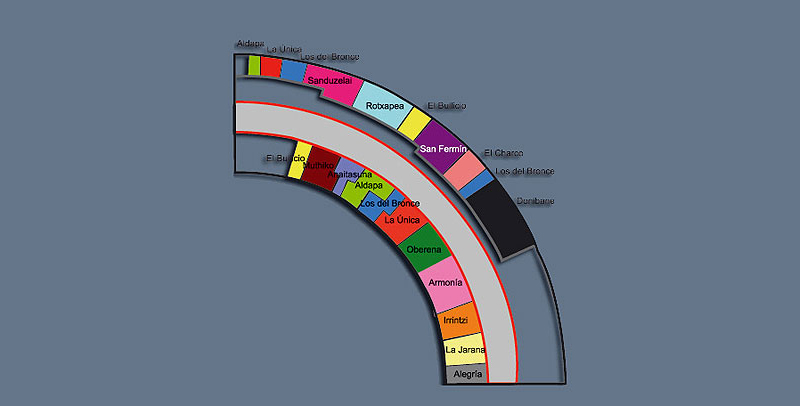
The apartado
The “Apartado” – this is where some of the personalities and well-known people who visit Pamplona for the fiestas, like to be seen. This is where the “draw” for the bulls is made and allocated to the three different bullfighters who will fight in the same afternoon.
But perhaps the most important thing is to see and be seen as it is really more of a social affair than anything else. It is necessary to pay for a ticket to enter this section of the bullring. One o´clock in the afternoon is an incredibly early hour of the day if you have been on the town all night. And this is one of the most inconvenient things about the visit to the enclosure.
This event takes place every day that there is a bullfight, which is to say, from the 6th to the 14th of July. If you are attacted to the atmosphere which surrounds the bullfighting world, it could be worth your while to make the effort to check out this daily event, even if you have had a long night of it.
To be admitted to the enclosure, you need to buy a ticket at one of the box-offices round the stadium between 10 o´clock and 1 o´clock each day from the 5th onwards. You go through an entrance of the ring which is usually reserved for the animals and keepers.
What is this?
Here, there is a kind of draw made to assign two bulls to each of the three bullfighters who will fight that same afternoon in the ring. At this point, the bulls who have been sharing a common corral since the morning run, are separated into their individual stalls. It´s a good opportunity for the real fans to size up the qualities and defects of each of the bulls. The numbers are placed in the hat of one of the stewards and drawn out for each bullfighter depending on a criteria of seniority, the oldest fighter being first. Then the bulls are put in their separate stalls.
The event attracts, not only the bullfighters, but also a lot of “important people”, local politicans, personalities, etc. which makes it one of these social occasions for the “in” people. But, in fact, a lot of perfectly ordinary people go along just to have a look. The event attracts, not only the bullfighters, but also a lot of “important people”, local politicans, personalities, etc. which makes it one of these social occasions for the “in” people. But, in fact, a lot of perfectly ordinary people go along just to have a look.
It might be of gastromonic interest for the foreign visitor to know that at the small bar, where one might like to sip a sherry or two, there is also a special snack available during these days of the Fiesta, which consists of the testicles of the bulls which have been killed in the previous afternoon´s fight. Delicious to the palate for some and a revulsion to to others!
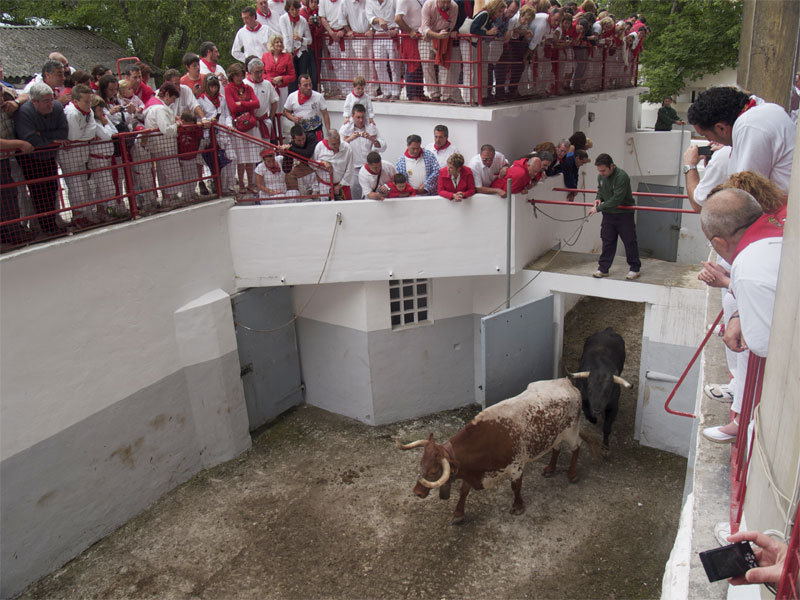
© Maite H. Mateo
What is a bull-fight?
A normal bullfight consists of three “tercios” and two “suertes”. In Pamplona there is an extra session which is the snack-break after the third bull. A normal bullfight is divided into three parts – first the “Varas” – where the cape is used to examine the qualities of the bull – second – the “Banderillas” – where the two assistants of the bullfighter attempt to play some darts on the bull’s back. The final part is the fight to the death of the bull. In addition, there are two “suertes” – this is the cape work from the bullfighter using two distinct capes – one with a wooden stick as a bar on the cape.
In Pamplona, after the third bull, there is the “suertes” (‘luck’) of the snack-break, which is usually something more than a snack. Here the people eat and drink heartily and little attention is paid to what is going on inside the ring.
The very first movement is when two horsemen, in all their plumed finery, suddenly burst into the middle of the ring at a gallop. They turn aside in opposite directions and gallop round the arena on each side. When their paths cross the public give a loud OOH ! to acclaim the possible collision which never happens. (Just another of those eternal little rites of San Fermin !)
Then comes the parade of the bull-fighters and their entourage, and all the other people who will have some part to play in the event such as the “picadores” on their horses and carrying their lance, the “banderilleros” who are dressed like the bull-fighters but whose function is to run at the bulls and stick darts into their backs as a preliminary to the bull-fighters work. There are others similarly dressed- the “Peones” – but whose function is simply to play with the bull with their coloured capes so that the bull-fighter can watch the way that the bull charges and turns with his horns.
The “Mulillas” also take part in the parade and these are the men and horses which will drag the body of the dead bull from the ring. After they salute the balcony of the president, permission is given for the bull-fight to begin. The same ritual which has gone on for countless years. There are three bull-fighters and two bulls for each one. The order is fixed: the first bull-fighter fights the first and fourth bull, the second one will fight the second and fifth, the third will fight the third and sixth bull.
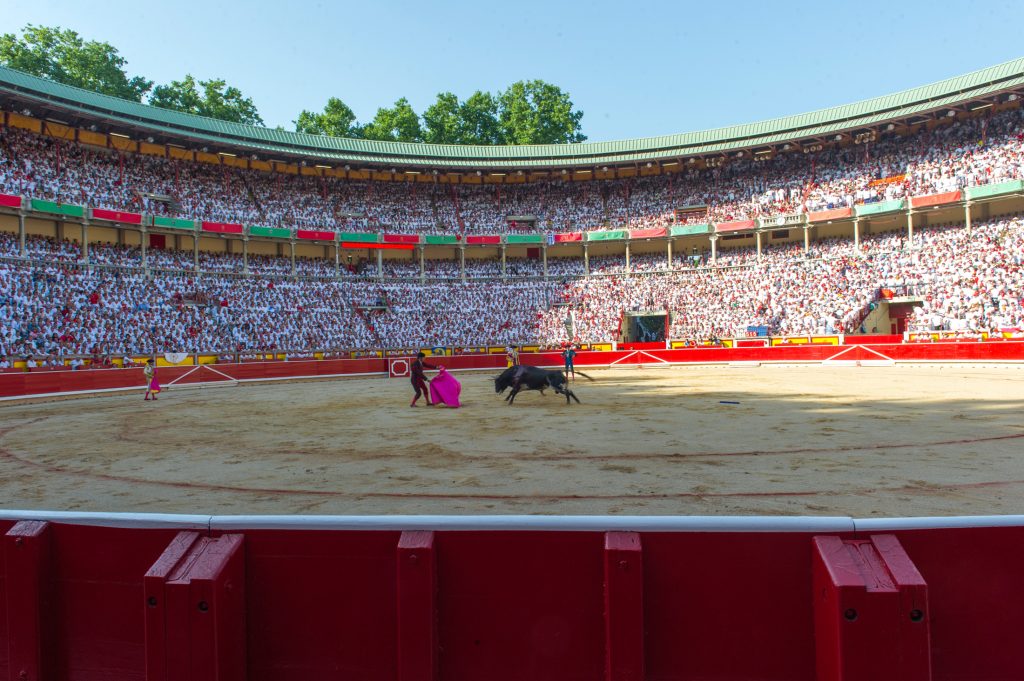
Sombra y sol. © Maite H Mateo.
Each bull-fight has three standard movements, called “tercios”:
The first “tercio” takes place as soon as the bull is released into the ring. The “peones” tempt the bull with their capes so that the quality of the bull charges can be appreciated. They will lead him over different sections of the ring so that his reactions can be carefully noted by the bull-fighter. Then the “Picador” appears with his horse and lance.
He will pierce the back of the bull with his steel lance to weaken it and to tame some of his fierce energy. This is known as making a “puya” and is not popular with the crowd as they don’t want the animal to be made too weak. On the other hand, the bull-fighter does want him to be weakened. The bull-fighter then plays with the bull with a yellow cape to learn more about the way it charges and turns.
The second “tercio” begins when the “banderilleros” take up their running position with a dart in each hand and they must run at the bull and stick these large darts, with a small steel hook at the end, into the back of the bull. There are usually three of these men who act in quick succession making a total of six darts in all.
The third “tercio” is when the bull-fighter uses his red and yellow cape held by a wooden sword. He carries out several different movements where he tries to dominate the bull. When the bull is sufficiently tired, he changes the wooden sword for a steel one and with this sword he will give the final “estocada” where he must bury the sword in a small area of the animal’s back to kill him.
Once the bull is dead, the president of the arena decides if he will concede any award to the bull-fighter. If he has done everything well, the public acclaim him and appeal for an award (This could be one ear, two ears, two ears and the tail, depending on how well he has done everything). If the bull-fighter has been bad, the crowd will boo and hiss and the luckless bull-fighter will have to wait for another better day.
And the crowd await the second bull and hope for a better fight. And that’s the ritual for all six bulls. And after that the show is over for another day.


